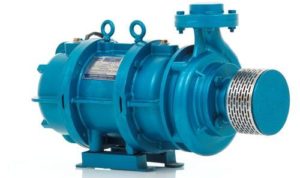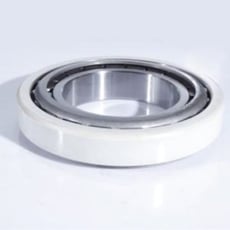Part 18 in a series of questions and answers from our Q&A webinars.
Q1. How are AEGIS Rings applied to submersible pump motors?
A1. It depends on the manufacturer and motor. Some motor designs have the bearings in an oil bath. That's a problem for now. We are developing grounding rings that can tolerate higher grease and oil levels.
But for now, you want any AEGIS ring to be running in a dry environment. We have grounding rings in plenty of submersible pumps. Just not in the oil-filled design.
Q2. What value of shaft voltage could be acceptable?
A2. We usually see zero to 35 V before shaft grounding. Say it's 15 V. Then you put on an AEGIS ring, add a braided grounding strap, and put colloidal silver on the shaft. The shaft voltage will usually decrease to under 1 V peak. This is about as safe as it gets, so we use one volt as a benchmark.
But we can't always get the shaft voltage so low. What you're most looking for is a big reduction. We had a situation recently with a shaft with 45-50 V on it. Our best practices brought it down to 3 V. So you may not get shaft voltage down to zero, and it may not be perfect. But decreased shaft voltage will improve things, and we'll work with you on whatever you've got.
Q3. You've said motors over 100 hp/75 kW need, along with AEGIS, an insulated bearing. But those are expensive and difficult to install. Can you just use two AEGIS rings instead, one at each end of the motor?
A3. You don't want to do that. That seems like a good idea, and we actually used to recommend two AEGIS rings. The logic was that the rings would offer much less resistance than the (ordinary) bearings, so the circulating current would only move through the rings. But we quickly found that it doesn't work as planned; current still circulated through the bearings. Which is surprising but true.
One insulated bearing opposite the AEGIS ring seems necessary to stop the circulating current. Lots of motor manufacturers are now installing insulated bearings at the non-drive end of larger motors. They do this with motors of 75 to 125 hp and up.
As for the expense: Yes, it's expensive. But not as expensive as bearing failure. Say you've got a 200 hp motor, with one SGR, on a drive. The motor is protected against shaft voltage discharge but not circulating current. So a bearing may fail. If that happens, it'll cost $5,000 to repair it. Plus, you'll need to ship it wherever for repair, plus you'll have the cost of downtime. Add an insulated bearing costs a lot less than the repair and downtime, by far.
AEGIS Rings also come with a 2-year extended warranty against bearing fluting damage. No other form of protection against VFD-caused bearing damage offers a warranty like this.
![]() To learn more about AEGIS shaft grounding and best practices for electrical bearing protection, sign up for a training. We offer monthly live training webinars, and - pandemic restrictions permitting - we can also visit your facility to review your exact application.
To learn more about AEGIS shaft grounding and best practices for electrical bearing protection, sign up for a training. We offer monthly live training webinars, and - pandemic restrictions permitting - we can also visit your facility to review your exact application.



